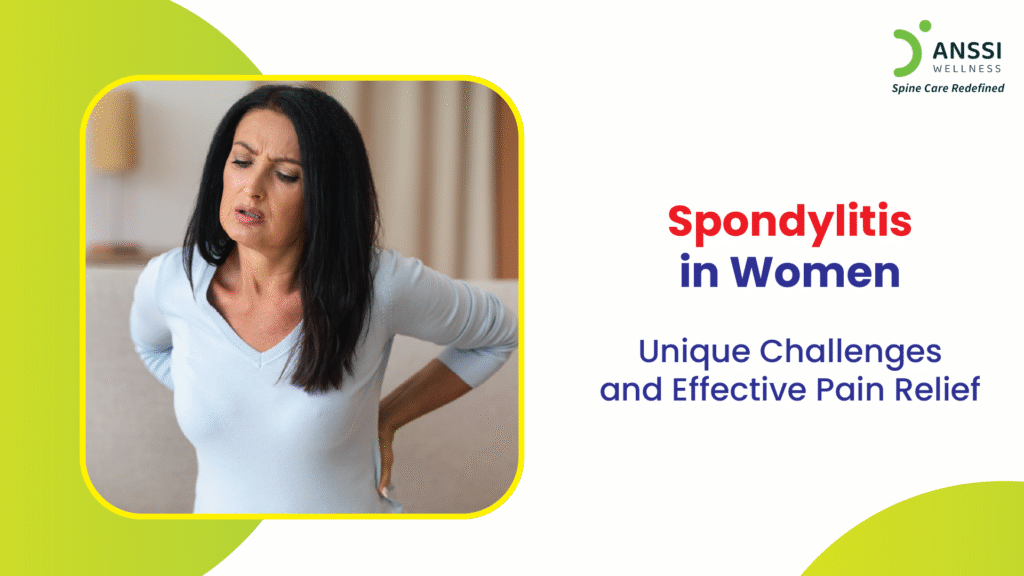Spondylitis is a chronic inflammatory condition that primarily affects the spine and surrounding joints. It can cause persistent pain, stiffness, and reduced mobility, significantly impacting day-to-day life. While spondylitis affects both men and women, research and clinical experience show that women face unique challenges in its diagnosis, symptoms, and management.
Understanding these differences and adopting effective strategies for pain relief can help women lead more comfortable, active lives despite the condition.
Understanding Spondylitis
Spondylitis is not a single disease; it includes conditions like Ankylosing Spondylitis (AS), which affects the sacroiliac joints and spine, and Cervical Spondylitis, which impacts the neck region.
Common symptoms include:
- Chronic back or neck pain that improves with movement but worsens with rest
- Morning stiffness lasting more than 30 minutes
- Fatigue and reduced flexibility.
Unique Challenges for Women
In women, symptoms often present differently from those in men. Instead of rapid progression and visible spinal fusion, women may experience milder but longer-lasting pain, more neck and upper back involvement, and subtle signs that are harder to detect in imaging tests. This often leads to delayed diagnosis, sometimes by years.
1. Hormonal Influences
Fluctuations in estrogen and progesterone levels during the menstrual cycle, pregnancy, and menopause can affect inflammation and pain sensitivity. Many women notice their symptoms intensify before menstruation or during menopause when estrogen levels drop.
2. Multiple Roles and Responsibilities
Balancing family care, household work, and professional life often means women have less time for self-care. Physical strain from lifting children, prolonged standing, or repetitive chores can worsen spondylitis symptoms.
3. Risk of Underdiagnosis
Women’s symptoms are sometimes mistaken for stress, poor posture, or general fatigue. Because spinal changes may be less obvious in X-rays, diagnosis can be delayed unless advanced imaging and specialist consultations are sought.
Effective Pain Relief Strategies
Living with spondylitis requires a comprehensive approach that combines lifestyle changes, exercise, and targeted treatments.
Lifestyle Modifications
- Posture Correction: Avoid slouching while sitting or standing. Use chairs with proper lumbar support. While sleeping, choose a firm mattress and supportive pillows.
- Ergonomic Adjustments: Arrange workspaces to minimise neck and back strain. Position screens at eye level, and avoid prolonged use of mobile devices without breaks.
- Anti-Inflammatory Diet: Include foods rich in omega-3 fatty acids (fish, walnuts, and Alsi seeds), antioxidants (berries, leafy greens), and anti-inflammatory spices (turmeric, ginger). Reduce processed foods and refined sugar.
- Adequate Hydration: Drinking enough water helps maintain joint lubrication and spinal disc health.
Exercise and Physiotherapy
Regular physical activity helps manage stiffness and prevents loss of mobility.
Recommended activities:
- Gentle Stretching: Neck tilts, shoulder rolls, and hamstring stretches to ease tension
- Core Strengthening: Exercises like bridges, planks, and pelvic tilts to support the spine
- Mobility Exercises: Swimming and yoga to improve flexibility without straining joints
A physiotherapist can design a program tailored to your condition, ensuring movements are safe and effective.
Advanced Non-Surgical Treatments
When lifestyle measures and exercise are not enough, modern non-invasive treatments offer significant relief without the risks of surgery.
1. Targeted Physiotherapy Programs
Combining manual therapy with strengthening exercises, targeted physiotherapy addresses the root cause of pain, restores mobility, and reduces flare-ups.
2. Other Pain Management Solutions
Low-level laser therapy, heat therapy, and posture correction training can further enhance recovery.
3. Non-Surgical Spinal Decompression Treatment
This USA-based technology gently stretches the spine, reducing pressure on spinal discs and nerves, while promoting natural healing. Non-surgical spinal decompression treatment is a completely non-invasive, drug-free, and needle-free procedure.
The Importance of Early Detection
Women experiencing persistent back or neck pain should not dismiss it as routine fatigue. Early detection and intervention can slow disease progression, prevent complications, and greatly improve quality of life.
Seek medical advice if:
- Pain lasts more than 3 months.
- Stiffness is worse in the morning and improves with movement.
- There is a family history of spondylitis or autoimmune disorders.
About ANSSI:
ANSSI Wellness focuses on improving the quality of life for patients suffering from spinal issues, aiming to provide relief where other conventional treatments have failed. Through advanced non-surgical spinal decompression treatment, ANSSI is committed to helping patients avoid surgery and recover in a safe, effective, and compassionate environment.
Connect with ANSSI Wellness on LinkedIn, Instagram, and Facebook for expert guidance.




